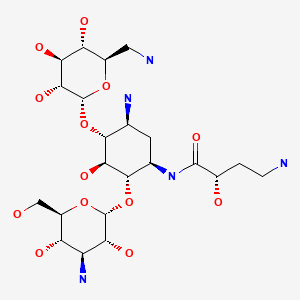CASRN: 37517-28-5

Drug Levels and Effects
Summary of Use during Lactation
Amikacin is poorly excreted into breastmilk. Newborn infants apparently absorb small amounts of other aminoglycosides, but serum levels with typical three times daily dosages are far below those attained when treating newborn infections and systemic effects of amikacin are unlikely. Older infants would be expected to absorb even less amikacin. Because there is little variability in the milk amikacin levels during multiple daily dose regimens, timing breastfeeding with respect to the dose is of little or no benefit in reducing infant exposure. Data are not available with single daily dose regimens. Monitor the infant for possible effects on the gastrointestinal flora, such as diarrhea, candidiasis (e.g., thrush, diaper rash) or rarely, blood in the stool indicating possible antibiotic-associated colitis.
Drug Levels
Maternal Levels. Two women were given a single dose of 100 mg amikacin intramuscularly, and milk levels were measured at 2 and 6 hours after the dose. Only trace levels were detected. In one woman on amikacin therapy, the peak amikacin milk level was 1.5 mg/L 2.5 hours after a 100 mg dose by injection.[1]
Two women were given a single 200 mg dose of amikacin intramuscularly and milk levels were measured hourly for 6 hours. They had only trace levels in milk 6 hours after the dose.[2]
A woman given a single dose of amikacin 100 mg intramuscularly had undetectable milk amikacin levels 1 and 2 hours after the dose and only trace amounts in milk at 4 and 6 hours after the dose.[3]
Infant Levels. Relevant published information was not found as of the revision date.
Effects in Breastfed Infants
Relevant published information was not found as of the revision date.
Effects on Lactation and Breastmilk
Relevant published information was not found as of the revision date.
References
- 1.
- Matsuda S, Mori S, Tanno M, Kashiwagura T. [Evaluation of amikacin in obstetric and gynecological fields]. Jpn J Antibiot 1974;27:633-6. [PubMed: 4617009]
- 2.
- Yuasa M. Evaluation of amikacin in gynecological and obstetric field. Jpn J Antibiot 1974;27:377-81. [PubMed: 4612187]
- 3.
- Matsuda S. Transfer of antibiotics into maternal milk. Biol Res Pregnancy Perinatol 1984;5:57-60. [PubMed: 6743732]
Substance Identification
Substance Name
Amikacin
CAS Registry Number
37517-28-5
Drug Class
Breast Feeding
Lactation
Milk, Human
Antibacterial Agents
Anti-infective Agents
Aminoglycosides
Disclaimer: Information presented in this database is not meant as a substitute for professional judgment. You should consult your healthcare provider for breastfeeding advice related to your particular situation. The U.S. government does not warrant or assume any liability or responsibility for the accuracy or completeness of the information on this Site.
Publication Details
Publication History
Last Revision: October 15, 2023.
Copyright
Attribution Statement: LactMed is a registered trademark of the U.S. Department of Health and Human Services.
Publisher
National Institute of Child Health and Human Development, Bethesda (MD)
NLM Citation
Drugs and Lactation Database (LactMed®) [Internet]. Bethesda (MD): National Institute of Child Health and Human Development; 2006-. Amikacin. [Updated 2023 Oct 15].